-
Cangzhou Yulong Steel Co., Ltd.
-
Phone:
+86 13303177267 -
Email:
admin@ylsteelfittings.com
- English
- Arabic
- Italian
- Spanish
- Portuguese
- German
- kazakh
- Persian
- Greek
- French
- Russian
- Polish
- Thai
- Indonesian
- Vietnamese
- Zulu
- Korean
- Uzbek
- Hindi
- Serbian
- Malay
- Ukrainian
- Gujarati
- Haitian Creole
- hausa
- hawaiian
- Hebrew
- Miao
- Hungarian
- Icelandic
- igbo
- irish
- Japanese
- Javanese
- Kannada
- Khmer
- Rwandese
- Afrikaans
- Albanian
- Amharic
- Armenian
- Azerbaijani
- Basque
- Belarusian
- Bengali
- Bosnian
- Bulgarian
- Catalan
- Cebuano
- China
- China (Taiwan)
- Corsican
- Croatian
- Czech
- Danish
- Esperanto
- Estonian
- Finnish
- Frisian
- Galician
- Georgian
- Kurdish
- Kyrgyz
- Lao
- Latin
- Latvian
- Lithuanian
- Luxembourgish
- Macedonian
- Malgashi
- Malayalam
- Maltese
- Maori
- Marathi
- Mongolian
- Myanmar
- Nepali
- Norwegian
- Norwegian
- Occitan
- Pashto
- Dutch
- Punjabi
- Romanian
- Samoan
- Scottish Gaelic
- Sesotho
- Shona
- Sindhi
- Sinhala
- Slovak
- Slovenian
- Somali
- Sundanese
- Swahili
- Swedish
- Tagalog
- Tajik
- Tamil
- Tatar
- Telugu
- Turkish
- Turkmen
- Urdu
- Uighur
- Welsh
- Bantu
- Yiddish
- Yoruba

Oct . 05, 2024 01:16 Back to list
types of welding in piping
Types of Welding in Piping
Welding is a critical process in various industries, particularly in the construction of piping systems. These systems serve as arteries for transporting fluids and gases, making it essential that they are constructed using reliable and durable welding methods. The choice of welding technique can greatly influence the efficiency, safety, and longevity of piping installations. This article explores the primary types of welding used in piping, highlighting their features, applications, and advantages.
1. Shielded Metal Arc Welding (SMAW)
Also known as stick welding, Shielded Metal Arc Welding is one of the oldest and most widely used welding methods. SMAW involves using a consumable electrode coated in flux to produce the weld. The heat generated by an electric arc formed between the electrode and the workpiece melts the base metal and the electrode, creating a strong joint.
SMAW is particularly beneficial in outdoor environments and in situations where the workpieces may be dirty or contaminated, as it is less sensitive to these conditions compared to other welding types. It is commonly used for welding carbon steel pipes and is favored in industries such as construction, shipbuilding, and heavy machinery repairs.
2. Gas Tungsten Arc Welding (GTAW)
Gas Tungsten Arc Welding, often referred to as TIG (Tungsten Inert Gas) welding, offers high precision and is used to create clean, high-quality welds. This method uses a non-consumable tungsten electrode to produce the weld, with an inert gas (usually argon or helium) shielding the weld area from contamination.
GTAW is particularly advantageous for welding thin materials and for applications where aesthetics are essential, as it produces very little spatter and allows for precise control over the heat input. Common applications include food and beverage processing pipelines and chemical processing industries, where materials need to be joined with minimal contamination.
3. Gas Metal Arc Welding (GMAW)
GMAW, or MIG (Metal Inert Gas) welding, utilizes a continuous wire feed as the electrode and an inert gas to protect the weld pool from atmospheric contamination. This method is known for its speed and efficiency, making it an excellent choice for large-scale piping projects.
types of welding in piping

MIG welding is versatile and can be used on a variety of metals, including aluminum and stainless steel. Its speed and ability to produce strong, clean welds quickly make it a popular choice among industries such as oil and gas, automotive manufacturing, and HVAC systems.
4. Submerged Arc Welding (SAW)
Submerged Arc Welding is a semi-automatic or automatic process where an arc is struck between a continuously fed electrode and the workpiece, with the arc and molten metal being submerged under a blanket of granular flux. This method is known for its deep penetration and high deposition rates, making it suitable for large-diameter pipes and thick-walled components.
SAW is commonly used in the production of large-scale welded structures, such as pipelines and pressure vessels, due to its efficiency and ability to produce strong welds with minimal defects.
5. Flux-Cored Arc Welding (FCAW)
Flux-Cored Arc Welding is similar to MIG welding but utilizes a tubular wire filled with flux. This method allows for better penetration, making it ideal for thick materials and out-of-position welding. FCAW can be used with or without shielding gas, providing flexibility based on the specific requirements of the project.
This technique is frequently used in construction, shipbuilding, and pipe fabrication due to its ability to create strong welds quickly in various environments.
Conclusion
Understanding the different types of welding in piping is essential for selecting the most appropriate method for specific applications. From the versatility of SMAW and the precision of GTAW to the speed of GMAW and the efficiency of SAW and FCAW, each welding technique has its unique strengths. By choosing the right welding process, industries can ensure the integrity and reliability of their piping systems, ultimately contributing to safer and more effective operations.
Latest news
-
ANSI 150P SS304 SO FLANGE
NewsFeb.14,2025
-
ASTM A333GR6 STEEL PIPE
NewsJan.20,2025
-
ANSI B16.5 WELDING NECK FLANGE
NewsJan.15,2026
-
ANSI B16.5 SLIP-ON FLANGE
NewsApr.19,2024
-
SABS 1123 FLANGE
NewsJan.15,2025
-
DIN86044 PLATE FLANGE
NewsApr.19,2024
-
DIN2527 BLIND FLANGE
NewsApr.12,2024
-
JIS B2311 Butt-Welding Fittings LR/SR 45°/90° /180°Seamless/Weld
NewsApr.23,2024











